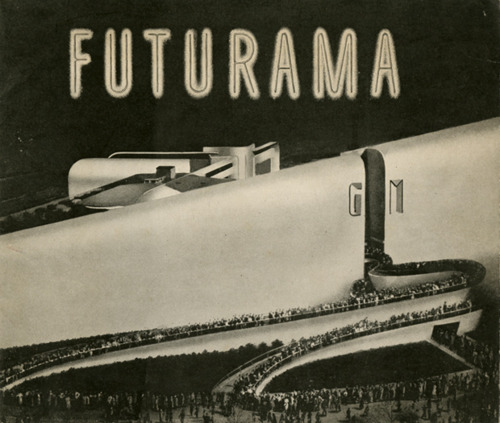[Image source: FUTURAMA. Published by General Motors, 1940. 24pp. Original wrappers. Provenance: the Pamphlet Collection, Library of Congress. ]
The 1939 World's Fair in NYC famously exhibited a spherical attraction that exhibited a semi-robotic display of what the future would be like--a future that was only 21 years away, in 1960. There would be an enormous amount of weight on the shoulders of 1960, given what the World's Fair had to say about it in 1939. Few things were very right, and many of course were necessarily wrong--but that must be the case when looking into the short-ended future with a monstrous amount of anticipation. That--and since this was a feel-good celebration--nobody was talking about the world war that had already started.
One thing is for sure--the pavilion's creator, General Motors, did foresee that highways and automobiles will be in high demand up there in the tomorrowland of 1960. The display was designed by the fantastic Norman bel Geddes, who actually expanded on his superhighway theme in the next year with his book Magic Motorways (which can be read here). Anyway people were very excited by the whole affair--waiting in line for a few hours, winding their way through the pavilion to take their seats in a circular gallery overlooking a vast and complex assemblage of miniature societal models, the seating arena rotated to give the viewers views of the entire display. More than 26 million people saw the display over a six month period.
26 million is a big number. Futurama drew as many people in six months as the three New York City baseball teams (the Yankees, Giants and Dodgers) brought in for almost the entire decade. It is also equal to all of the deaths suffered by the Soviet Union during WWII.
I guess this was as good a vision as any--or at least it didn't seem to involve very much planning outside the new automatic automobile nervous system that would leech into the life-blood of the country. Other planned visions of the future do not look quite so good. For example, Le Corbuser's demolition of central Paris to make way for his Soviet apartment block reconstruction in his Voisin Plan (1925):
Again, this is not a wholesale look into the future, just the resurfacing of one of the world's greatest cities.
A man with a little bigger vision, Frank Lloyd Wright, saw a heavier future in his Broadacre CIty:
I'm not sure how these domed cities worked. B. Fuller had an idea like this for central Manhattan that I wrote about earlier in this blog, but his idea escaped me too.




Comments